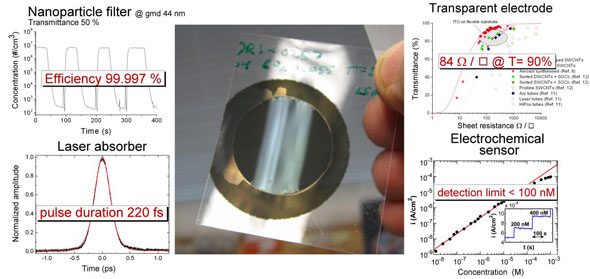| May 13, 2011 |
Free-standing single-walled carbon nanotube thin films
|
|
(Nanowerk News) Single-walled CNTs (SWCNTs) are a unique family of materials exhibiting diverse useful chemical and physical properties.
|
|
Thin films of SWCNTs have many unique properties such as high porosity and specific surface area, low density, high ratio of optical transmittance to sheet resistance, high thermal conductivity and chemical sensitivity, and tunable metallic and semiconducting properties.
|
|
Recently researchers from Department of Applied Physics at Aalto University (Finland) in collaboration with Canatu Ltd. (Finland) have discovered a simple and rapid method to prepare thin multifunctional single-walled carbon nanotube films without any substrate (free-standing films). Usually SWCNT films are prepared from suspensions of SWCNTs by a liquid filtration. This method typically involves several time and resource consuming and potentially detrimental liquid dispersion and purification steps ending up with dense SWCNT networks on a filter, which have a transfer issue. Moreover, preparation of free-standing films by the vacuum-filtration method is still a challenging task.
|
 |
| A collage of images: a photograph of the free-stading SWCNTs supported by a polymer film at the edges and varous graphs demonstrating oustanding perormance in different devices such as an aerosol filter, a laser absrober, a transparent and flexible electrode, and an electrochemical sensor.
|
|
"Our method allows the preparation of SWCNT deposits both on different substrates and in the form of free-standing films during less than 15 s. This becomes possible due to the fact that the SWCNTs produced in the gas phase synthesis process gave very high purity and crystallinity, can be directly deposit from the gas to a substrate and accordingly be directly utilised without additional purification steps," tells Dr. David P. Brown, CEO of the company Canatu Ltd, which commercializes the SWCNT films.
|
|
The method easily allows Canatu to alter the thickness of multifunctional free-standing SWCNT films from a sub-monolayer (when the amount of SWCNTs is insufficient to create a single continuous layer) to a few micrometers.
|
|
Collaboration with other Finnish universities
|
|
According to the researchers, the collaboration with other Finnish universities and institutions, Tampere University of Technology and Oulu University, was extremely important to investigate the unique properties and to demonstrate the multifunctionality of this unique material.
|
|
"We fabricated the state-of-the-art components for filtration of aerosol nanoparticles, transparent, flexible and highly conductive electrodes, extremely sensitive electrochemical sensors, polymer free saturable laser absorbers, gas heaters, thermo acoustic loudspeakers, and gas flow meters," says professor Esko I. Kauppinen, the leader of the research group.
|
|
SWCNT films - wide range of applications
|
|
"However, the wide range of applications is not limited to those reported in our paper. The superior mechanical and electrical properties of these films suggest potential uses in a broad range of other devices. As a filter, SWCNT films could be used for filtration of bacteria and viruses. The possibility to heat SWCNT films can be utilized for water or air sterilization. Additionally, since SWCNTs contain iron particles embedded inside them, one could exploit their magnetic properties. Their high strength coupled with high electrical conductivity could be employed in novel energy generators, electromagnetic interference shielding, flexible radio frequency identification tags, touch sensors, flat panel displays and static-charge dissipators. The ultrahigh surface area coupled with high electrical conductivity could be used in advanced solar cells and super capacitors," Dr. Albert G. Nasibulin, the leader of this project and the first author of the article related to the discovery of multifunctional free-standing SWCNTs concludes.
|
|
The results has been recently published in a distinguished scientific journal ASC Nano ("Multifunctional Free-Standing Single-Walled Carbon Nanotube Films").
|
|
Even though graphene has recently attracted much attention from the research community, some properties of SWCNTs, such as porosity, mechanical strength, and fine-tunability of optical and electrical properties, provide many applications where the flat, single-layered carbon structure cannot compete with its tubular 'brother'.
|

